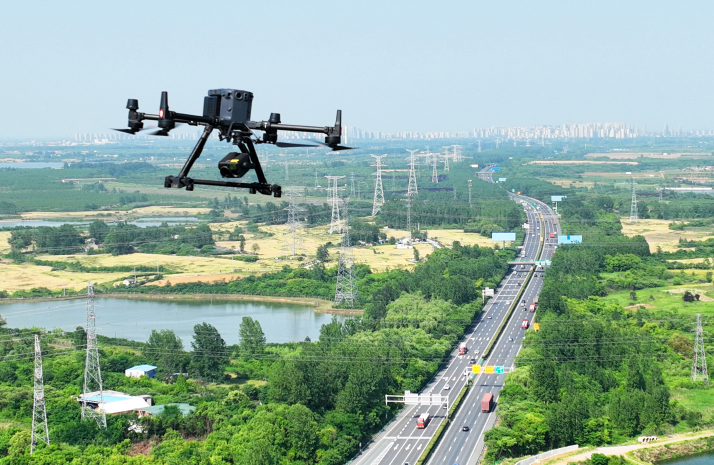| Business |
| Innovation drives a new horizon in the low-altitude economy | |
|
|
 A drone conducts a road inspection along a preset route in Hefei, Anhui Province, on May 17 (XINHUA)
Defined as activities in airspace below 1,000 meters, low-altitude economy leverages manned and unmanned aircraft, driving integrated development across industries.
Whereas Western nations did get a head start in this sector, with the global push for the low-altitude economy beginning in 2016 as the United States Federal Aviation Administration issued Rule 107—governing the operation of commercial drones, China has been catching up rapidly in recent years thanks to its development in unmanned aircraft. In mid-November, the wide array of drone products presented at the China Airshow in Zhuhai in south China's Guangdong Province showcased the potential of the country's low-altitude economy. The market value of China's low-altitude economy reached 505.95 billion yuan ($70 billion) in 2023, according to a report by market research firm CCID Consulting, and is projected to surpass 1 trillion yuan ($137 billion) in 2026. A new economic blue ocean is poised for takeoff. Lighting up the global stage In late September, right before China's National Day holiday (October 1-7), Shenzhen, the bustling tech hub in Guangdong, set a world record with a stunning drone display over the Shenzhen Bay. No fewer than 10,197 drones lit up the night sky, earning two Guinness World Records for the most drones controlled by a single computer and the largest aerial pattern created by drones. The performance impressed locals, tourists and international audiences alike, including Tesla founder Elon Musk, who called it "impressive" on X. The shows attracted visitors from across China, particularly from Hong Kong and Macao special administrative regions, leading to a 50-percent year-on-year increase in hotel bookings during the holiday, according to Qunar, a reputed Chinese online travel service provider. From creating colossal 3D portraits of Saudi leaders during Saudi Arabia's National Day celebrations on September 23, to lighting up the Eiffel Tower with vibrant patterns for the 2024 Paris Olympics this summer, Shenzhen has positioned drones as a symbol of Chinese technological and cultural innovation. Application reigns supreme But artistry aside, in Shenzhen, drones are seamlessly integrated into daily life. Drones of Meituan, China's largest on-demand delivery-service provider, operate year-round, regardless of weather, delivering items like beverages and pastries from their launch sites to cabinets kilometers away. "Urban low-altitude conditions are dynamic," said Yan Yan, head of Meituan Drones' Public Affairs. "Our drones are designed to adapt to moderate rain, snow, winds up to level 6 [on the Beaufort scale] and dim light," she told Xinhua News Agency. As of September, Meituan had opened 43 drone delivery routes in cities including Shenzhen, Beijing, Shanghai, Guangzhou in Guangdong, and Nanjing in Jiangsu Province, completing over 360,000 orders since unveiling its drone deliveries in Shenzhen in 2021, according to the company. Shenzhen leads in the low-altitude economy. According to Shenzhen's transportation authorities, the city launched 156 drone delivery routes in 2023, altogether completing over 600,000 flights. It also hosts over 1,700 drone(-related) enterprises in 2023 with an output value nearing 96 billion yuan ($13 billion). Early in 2024, the city pioneered national legislation to provide legal protection for drone applications, which now cover light shows, deliveries, travel and search and rescue missions. "The low-altitude economy offers more dimensions, industries and applications compared to ground transportation, hence its rapid development momentum," Xiang Zheng, Deputy Secretary General of the Shenzhen Unmanned Aerial Vehicle (UAV) Industry Association, told Beijing Review. Expanding the framework In major agricultural provinces, farmers are using drones for pesticide spraying, seeding and fertilization, with some regions including agricultural drones in machinery subsidies. Drones are also widely used for surveying, emergency response and grid inspection, replacing helicopters and reducing costs. Future drone applications, some of which are already undergoing continuous testing and fine-tuning, include clinical blood transport, delivering saplings to mountaintops, firefighting in skyscrapers, and inspecting hazardous passageways. The low-altitude economy also offers entirely new perspectives and experiences for travel, tourism and consumption. Chen Xueqing, a 29-year-old from Beijing, recently experienced flying a light aircraft as an amateur pilot alongside a co-pilot. She chose the same fixed-wing aircraft featured in The Tale of Rose, a hit Chinese TV series starring popular actress Liu Yifei, which highlights themes of female empowerment. Inspired by the show's protagonist, Chen described the experience as "a tribute to her flying dreams." "I wasn't great at controlling the plane, but with the coach's guidance, it was exhilarating," she told Beijing Review. "Seeing the Great Wall made me want to climb it right then and there." This summer, Badaling Airport in Beijing's Yanqing District, where the series was filmed, saw a surge in tourism, with near-capacity bookings on weekends. Zhao Yongbing, Chairman of the airport management company, credited government support for integrating technologies like unmanned vehicles and renewable energy with low-altitude tourism, creating a unique local industry ecosystem. The airport offers a three-minute flight to the Badaling section of the Great Wall, while Yanqing District also features skydiving and powered paragliding. Low-altitude tourism, as an emerging travel trend, caters to consumers' growing demand for high-quality, unique experiences, Zhao told Beijing Review, adding that it also plays a role in fostering mutual growth across related industries. In August, the State Council, China's highest state administrative organ, issued guidelines promoting diverse tourism offerings, including low-altitude flying, to enhance service consumption quality. As a result, low-altitude cultural tourism is entering a period of rapid growth.  "Flying car" makers exhibit their products at the automobile area of the Seventh China International Import Expo in Shanghai on November 9 (CNSPHOTO)
A national bird's-eye view Since incorporating the sector into its national strategy in 2021, nearly 30 provincial-level regions have incorporated low-altitude economy goals into their government work plans, according to data from the State Information Center of China. Guangdong targets a 300-billion-yuan ($41-billion), self-sufficient industry by 2026, while Shanghai intends to team up with the Yangtze River Delta area to create the country's first inter-provincial low-altitude air network, packing more than 100 application scenarios, by 2027. Beijing plans to grow its number of related enterprises to over 5,000 within the next three years and become a national leader in the sector's innovation and policy development. Governments at all levels across China are actively supporting this sector. Hefei in east China's Anhui Province, for example, offers subsidies for UAV airworthiness certification, while Shanghai and Hangzhou in east China's Zhejiang Province encourage academia-industry collaboration to drive innovation. These efforts fuel aviation, UAV manufacturing and job creation. In Jiangsu, the Yancheng Technician College launched a UAV major in 2020, with graduates securing employment in various tech firms. Chen Tao, Dean of Traffic College at Yancheng Technician College, told Beijing Review that "college-enterprise cooperation" is pivotal to the major's success. Future direction At an industry forum in Jiangsu in November, the China Air Transport Association announced six pilot zones for electric vertical take-off and landing (eVTOL) aircraft to improve airspace management and safety, focusing on data integration and intelligent command systems. These zones will be located in Shenzhen, Suzhou, Hangzhou, Hefei, Chengdu and Chongqing. The pilot plan outlines routes and regions for eVTOLs, authorizing local governments to manage airspace below 600 meters, thus increasing their management responsibilities, newspaper Guangming Daily reported. EVTOLs, critical to the low-altitude economy, are eco-friendly electric aircraft designed for vertical takeoff and landing without runways. Unlike helicopters, they rely on electric engines for quieter, greener operations, while their human-focused design differentiates them from drones. Despite being called "flying electric cars," their potential applications extend far beyond conventional transportation. Urban air mobility is a pivotal future use for eVTOLs, offering solutions to traffic congestion and meeting growing demands for faster, more efficient travel. In March, Shenzhen's Shengshilong eVTOL completed a flight from the city's Shekou Cruise Home Port to Zhuhai's Jiuzhou Port, cutting a 2.5-hour land journey to merely 20 minutes. On April 7, EHang in Guangzhou received the world's first eVTOL production license from the Civil Aviation Administration of China, enabling mass production and global export of made-in-China eVTOLs. China's leading electric vehicle companies are also venturing into the aerial market. For example, Xpeng Aeroht, the "flying car" subsidiary of Xpeng Motors, plans to mass-produce its first eVTOL by 2026, following its manned flight debut at this year's China Airshow in Zhuhai.  A drone performance in Shenzhen, Guangdong Province, on September 26 (XINHUA)
Despite challenges like urban airspace allocation, infrastructure costs, and noise concerns, the low-altitude economy represents a new era of opportunities and innovation. At the Understanding China Conference held in Guangzhou in early December, Wu Dong, Dean of the Air Traffic Management Research Institute at Nanyang Technological University in Singapore, discussed the challenges of developing the low-altitude economy. Wu noted that while the rapid expansion of this sector presents economic opportunities, urban areas face challenges, particularly in managing airspace in densely populated regions and allocating limited airspace resources. Additionally, high costs for ground infrastructure, reliability requirements for communication systems and noise control issues require the collective efforts from all industry stakeholders to address. Nevertheless, the era of the low-altitude economy has arrived, and its future awaits further exploration and creation. It is ready to take flight. (Xu Bei, Zhao Wei and Zhang Shasha contributed to this story) (Print edition title: UP, UP AND AWAY!) Copyedited by Elsbeth van Paridon Comments to taozihui@cicgamericas.com |
|
||||||||||||||||||||||||||||
|